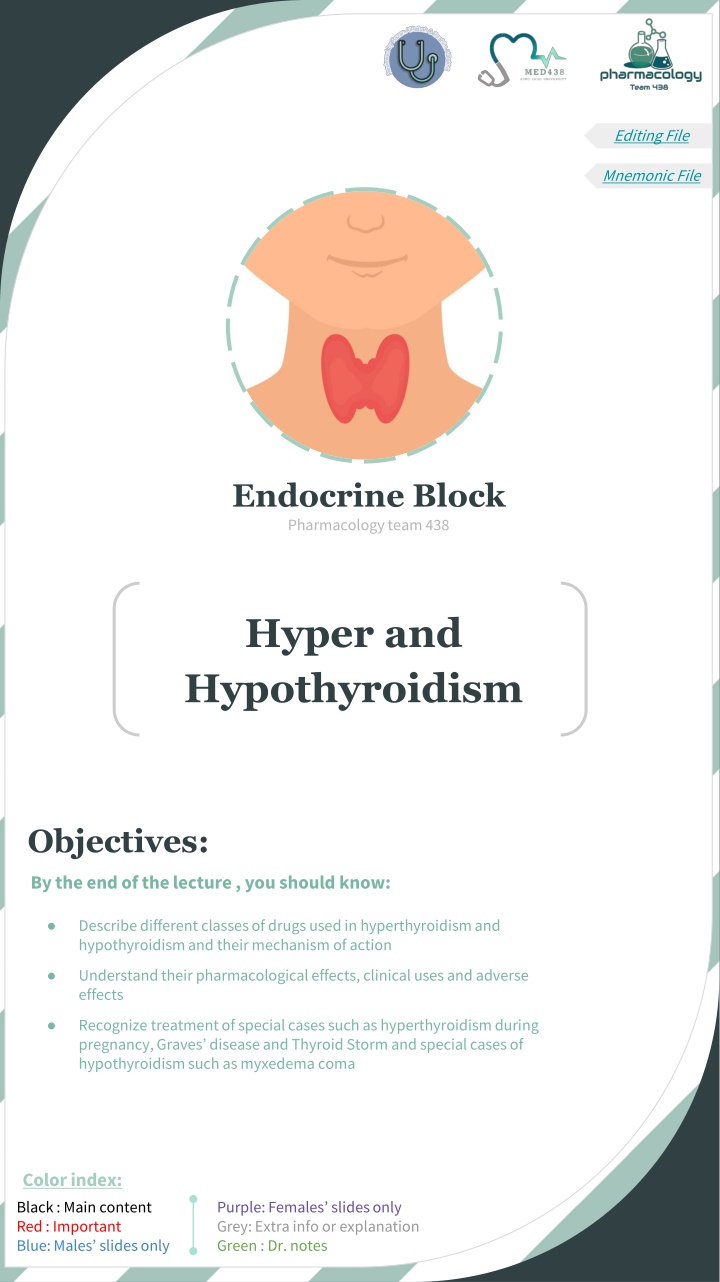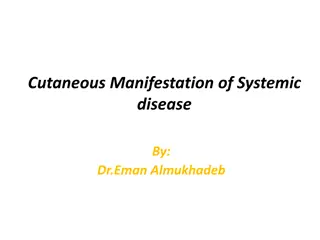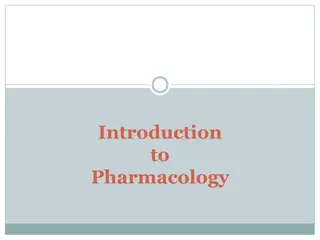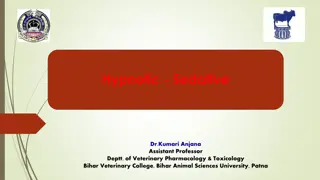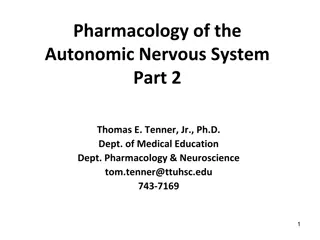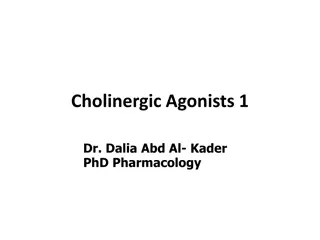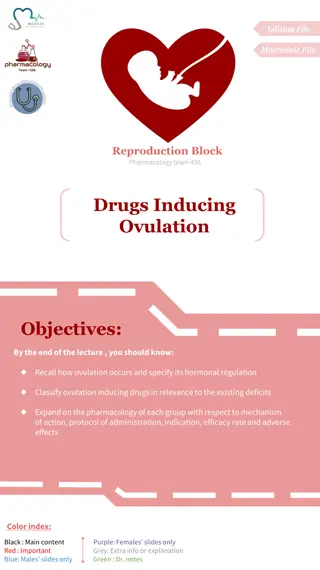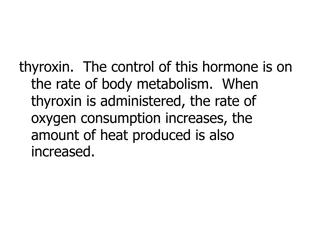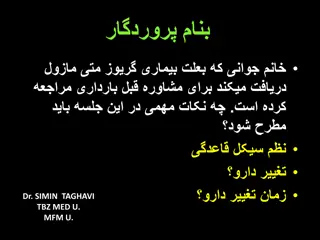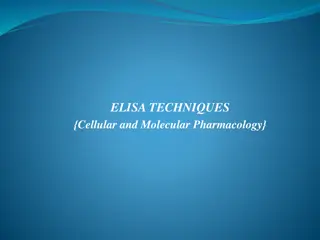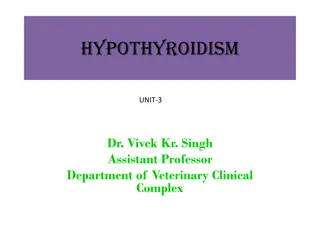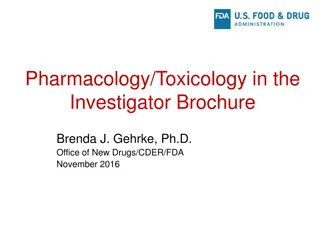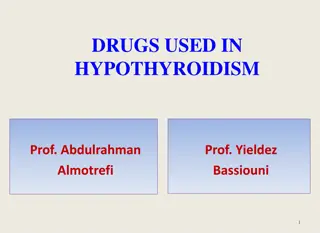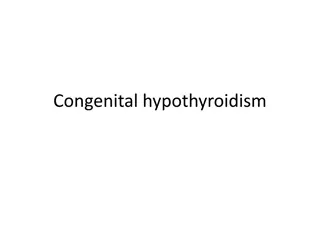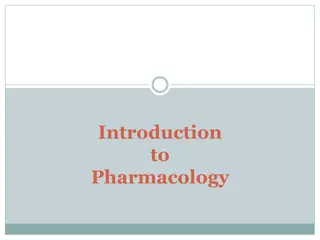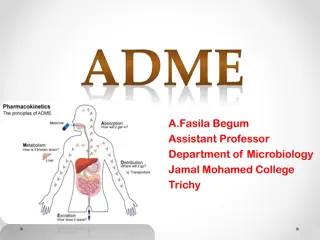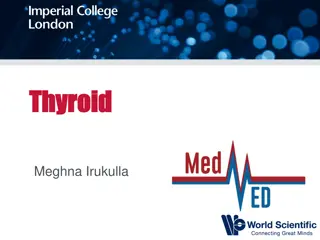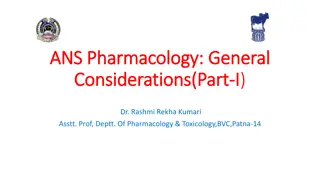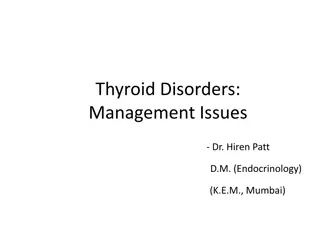Pharmacology of Hyperthyroidism and Hypothyroidism
Learn about the different classes of drugs used in hyperthyroidism and hypothyroidism, their mechanisms of action, pharmacological effects, clinical uses, adverse effects, and treatment of special cases such as hyperthyroidism during pregnancy and Graves disease. Understand the importance of thyroid hormones, iodine metabolism, and thyroid regulation in maintaining normal growth, development, and metabolic functions in the body.
Download Presentation

Please find below an Image/Link to download the presentation.
The content on the website is provided AS IS for your information and personal use only. It may not be sold, licensed, or shared on other websites without obtaining consent from the author.If you encounter any issues during the download, it is possible that the publisher has removed the file from their server.
You are allowed to download the files provided on this website for personal or commercial use, subject to the condition that they are used lawfully. All files are the property of their respective owners.
The content on the website is provided AS IS for your information and personal use only. It may not be sold, licensed, or shared on other websites without obtaining consent from the author.
E N D
Presentation Transcript
Editing File Mnemonic File Endocrine Block Pharmacology team 438 Hyper and Hypothyroidism Objectives: By the end of the lecture , you should know: Describe different classes of drugs used in hyperthyroidism and hypothyroidism and their mechanism of action Understand their pharmacological effects, clinical uses and adverse effects Recognize treatment of special cases such as hyperthyroidism during pregnancy, Graves disease and Thyroid Storm and special cases of hypothyroidism such as myxedema coma Color index: Black : Main content Red : Important Blue: Males slides only Purple: Females slides only Grey: Extra info or explanation Green : Dr. notes
Hyperthyroidism Thyroid Function Normal amount of thyroid hormones are essential for normal growth and development by maintaining the level of energy metabolism in the tissue. Either too little or too much thyroid hormones will bring disorders to the body. Important Functions CVS: increase heart rate & cardiac output which increase oxygen demand Growth & development, especially in the embryo & brain Thermoregulation increase basal metabolic rate (BMR) Helpsmaintain metabolic energy balance Iodine Importance Thyroid hormones are unique biological molecules in that they incorporate iodine1in their structure Adequate iodine intake (diet, water) is required for normal thyroid hormone production Major sources of iodine are: iodized salt, iodated bread, dairy products, shellfish Minimum requirement: 75 micrograms/day Iodine Metabolism 2 3 1 Iodide taken up by the thyroid gland is oxidized by peroxidase in the lumen of the follicle: I- Iodide Dietary iodine is absorbed in the GI tract, then taken up by the thyroid gland (or removed from the body by the kidneys) Oxidized iodine can then be used in production of thyroid hormones I2 Peroxidase Iodine Thyroid Hormones2 Tetraiodothyronine (T4\ thyroxine) Triiodothyronine (T3) Synthesis Oxidation of iodine: (to its active form) thyroid peroxidase (key enzyme of the synthesis) Iodine Formation of T4 and T3from MIT and DIT: Thyroid peroxidase Iodine trapping: uptake of iodine by the thyroid gland organification: The iodination of tyrosyl groups of thyroglobulin into MIT and DIT 1: Cannot be synthesized by the body, has to be supplied by diet. 2: once produced, they can control their own levels by feedback mechanisms
Thyroid Regulation 1. Hypothalamus secretes Thyrotropin-Releasing Hormone (TRH) which stimulates synthesis and release of thyrotropin (Thyroid Stimulating Hormone or TSH) by the anterior pituitary. - Hypothalamus TRH + 1. TSH then stimulates the thyroid gland to uptake iodine, synthesize and release T4&T3. - Ant. pituitary 1. T4 & T3 levels feedback to both hypothalamus and pituitary affecting the release of TRH & TSH. TSH + 1. Thyroid hormones exert negative feedback on TSH release at the level of the anterior pituitary: a. Inhibition of TSH synthesis. b. Decrease in pituitary receptor for TRH. Thyroid gland 1. TSH release is influenced by hypothalamic (TRH), and by thyroid hormones themselves T3 / T4 Thyroid Hormone Disorders Hypothyroidism: Refers to disorders in which the thyroid gland secretes decreased amounts of hormones Thyroid neoplasia: Benign enlargement or malignancies of the gland Thyrotoxicosis: Is a term for all disorders with increased levels of circulating thyroid hormones1 Hyperthyroidism: Refers to disorders in which the thyroid gland secretes increased amounts of hormones Also defined as: Hypermetabolic state cause by thyroid hormone excess at the tissue level Also defined as: Increased thyroid hormone synthesis and secretion Not all patients with thyrotoxicosis have hyperthyroidism All patients with hyperthyroidism have thyrotoxicosis Causes of Thyrotoxicosis2 Thyroiditis With low Graves disease (60-80%) RAIU With High Iodine-induced thyrotoxicosis: RAIU Multinodular goitre (14%) Drugs (e.g. amiodarone3) Radiografic contrast media Adenomas/ Carcinomas 1: Regardless of the cause. Therefor we can consider hyperthyroidism is a type of thyrotoxicosis but not vise versa. 2: Tested by hyperactive iodine uptake. 3: a powerful anti arrhythmic drug that contains iodine.
Features of Diseases Features of Graves Disease (diffuse toxic goiter) Cause by thyroid stimulating immunoglobulinsthat stimulate TSH receptor, resulting in sustained thyroid over activity. Mainly in young adults aged 20-25 5 times more frequent in women Exophthalmos Swelling and soft tissues of hands and feet Normal Goiter Clubbing of fingers and toes pretibial myxedema Half of cases have Exophthalmos (not seen with other causes of hyperthyroidism) 5% have pretibial myxedemia(thyroid dermopathy) Features of Toxic Multinodular Goiter Second most common cause of hyperthyroidism Most cases in women in 5th to 7th decades Often have long-standing goiter(chronic) Symptoms usually develop slowly Thyrotoxicosis Symptoms: Signs: Irritability Arrhythmia Dysphoria Thyroid enlargement Heat intolerance and sweating1 Warm, moist skin Palpitations Fatigue & weakness Exophthalmos Weight loss2 Pretibial myxedema Diarrhea Treatment of Hyperthyroidism 03 04 01 05 02 Thioamides (Antithyroids) Iodides\ Iodine Radioactive Iodine Surgery -blockers 1: Very typical presentation, characteristic for graves. 2:Despite increased food uptake
1) Thioamides Methimazole\Carbimazole Drugs Propylthiouracil (PTU) Carbimazole:prodrug converted to the active metabolite methimazole BothPTU and Methimazole:Inhibits synthesis of thyroid hormones by inhibiting the peroxidase enzyme that catalyzes the iodination of tyrosine residues. Additional Mechanism for PTU ONLY: blocks the conversion of T4 to T3in peripheral tissues MOA Rapidly absorbed Rapidly absorbed Protein binding: most of the drug is free1 Protein binding: 80-90% Accumulation: in thyroid Accumulation: in thyroid P.K Excreted by kidneys as inactive metabolite within 24 hours Excretion is slow, 60-70% of drug is recovered in urine in 48 hours2 Half-life: 1.5 hours (short) Half-life: 6 hours (long)2 Administered every 6-8 hours Administered every 8 hours Crosses placenta less readilyas it is highly protein bound Recommendedin pregnancy Concentrated in thyroid & crosses placenta Not recommended in pregnancy Pregnancy Breast feeding Less secreted in breast milk Recommended Secreted Notrecommended Skin reactions (frequency: 4-6%): Urticarial or macular reaction3 Arthralgia (1-5%) GIT effects (1-5%): Gastric distress and nausea Polyarthritis (1-2%): So-called anti-thyroid arthritis4 Agranulocytosis(0.1-0.5%): Seen in patients with Graves disease; occurs within 90 days of treatment ADRs Immunoallergic hepatitis(0.1-0.5%) Abnormal sense of taste or smell (rare) ANCA-positive vasculitis (Anti-neutrophil cytoplasmic antibodies5) (rare) 2) Iodine\ Iodide 1-Organic iodides: iopanoic acid or ipodate 2-Potassium iodide or lugol s solution Drug Inhibit thyroid hormone synthesis and release Block the peripheral conversion of T4to T3 The effect is not sustained6(produce a temporary remission of symptoms) MOA Prior to thyroid surgery to decrease vascularity & the size of gland Following radioactive iodine therapy Thyrotoxicosis Uses Should not be used as single therapy Should not be used in pregnancy7 C.I May produce iodism8(rare, as iodine isn t much used now), Iodism symptoms: skin rash, hypersalivation, oral ulcers, metallic taste, bad breath ADR 1: More free drug = more drug available to induce its action 2: Long duration of action = less frequent administration. 3: most common side effect. 4: that is why when a patient comes complaining of arthritis always ask about medications. 5: test for ANCA levels when treating with PTU. 6: should not be given alone unless used for a short period of time. 7: cross the placenta 8: only if given in large amounts
3) Radioactive Iodine (RAI) Drug Radioactive Iodine (RAI) 131 I isotope (therapeutic effect due to emission of rays1) Accumulates in the thyroid gland and destroys parenchymal cells, producing a long-term decrease in thyroid hormone levels. MOA Clinical improvement may take 2-3 months Half-life 5 days Cross placenta & excreted in breast milk = C.I in pregnancy and breastfeeding Available as a solution or in capsules Advantages: Easy to administer, effective, painless and less expensive safe if given within therapeutic dose, and less toxic than other drugs Disadvantages: High incidence of delayed hypothyroidism2 Large doses have cytotoxic actions (necrosis3of follicular cells followed by fibrosis) May cause genetic damage May cause leukemia & neoplasia induced by the genetic damage P.K Hyperthyroidism mainly inold patients (above 40) Graves disease Patients with toxic nodular goiter5 Can be used as a diagnostic method Uses4 4) -blockers6 Drug Propranolol\Atenolol\Metoprolol Adjunctive therapy to relief the adrenergic symptoms of hyperthyroidism such as tremors, palpitation, heat intolerance and nervousness Uses C.I Propranolol7is contraindicated in asthmatic patients 5) Thyroidectomy Sub-total thyroidectomy is the treatment of choice in very large gland or multinodular goiter Summary for the MOAs 1: leading to disruption of the hyperactive follicles. 2: due to disruption of more follicles than intended = production of less hormones than normal. 3: as necrosis is irreversible, if patient reaches to this stages, he/she will need life-long supplementation of thyroid hormones 4: RAI can be used for both diagnostic and therapeutic measures. 5: to decrease functional cells 6: symptomatic treatment only (treats the symptoms of sympathetic activation induced by excess thyroid hormones) 7: non-selective, possibly leading to bronchospasm
Special Conditions of Hyperthyroidism and their Management Better to start therapy beforepregnancy with 131I or subtotal thyroidectomy to avoid acute exacerbation during pregnancy During pregnancy: Radioiodine is contraindicated Propylthiouracilis the drug of choice during pregnancy Thyrotoxicosis Thyrotoxicosis Thyrotoxicosis during pregnancy pregnancy pregnancy Thyrotoxicosis during during during pregnancy It is a medical emergency of a sudden acute exacerbation of all the symptoms of thyrotoxicosis, presenting as a life-threatening syndrome. There is hypermetabolism, and excessive adrenergic activity, death may occur due to heart failure and shock. Thyroid Storm Management of Thyroid Storm: 1. It should be treated in an ICU for close monitoring of vital signs and for access to invasive monitoring and inotropic support 1. Correct electrolyte abnormalities, treat cardiac arrhythmia (if present) & aggressively control hyperthermia by applying ice packs 1. Promptly administer antiadrenergic drugs (e.g. propranolol) to minimize sympathomimetic symptoms (Life saving treatment) 1. High-dose propylthiouracil (PTU) is preferred because of its early onset of action, but it has a risk of severe liver injury and acute liver failure. 1. Administer iodine compounds (Lugol s iodine or potassium iodide) orally or via a nasogastric tube. 1. Hydrocortisone50 mg IV every 6 hours to prevent shock. 1. Rarely, plasmapheresis has been used to treat Thyroid Storm. Management of Graves Disease Severe Hyperthyroidism: Mild/Moderate Hyperthyroidism [small or moderately enlarged thyroid; children or pregnant or lactating women] [markedly elevated serum T4 or T3 and very large goitre, >4 times normal] Primary antithyroiddrug therapy should be considered Definitive therapy with radioiodine preferred in adults 1 1 Normalization of thyroid function with antithyroid drugs before surgery in elderly patients and those with heart disease Start methimazole, 5-30 mg/day, (PTU preferred in pregnant women) 2 2 Monitor thyroid function every 4-6 weeks until euthyroid state achieved 3 Discontinue drug therapy after 12-18 Relapse: Definitive radioiodine therapy in adults (second course of antithyroid drug therapy in children) 4 Monitor thyroid function every 2 months for 6 months, then less frequently, if: 5 Remission: Monitor thyroid function every 12 months indefinitely
Hypothyroidism Hypothyroidism Thyroid gland does not produce enough hormones May be congenital, primary or secondary Congenital: in children, hypothyroidism leads to delay in growth (dwarfism) and intellectual development (cretinism) People who are most at risk include those over age 50 & mainly in females Prevalence is 14/1000 females and 1/1000 males . Diagnosed by low plasma levels of T3 & T4 and TSH Types of Hypothyroidism Primary: Inadequate function of the gland itself. Iodine deficiency: most common cause of primary hypothyroidism & endemic goiterworldwide Autoimmune: Hashimoto s thyroiditis Radioactive iodine treatment of hyperthyroidism Post-thyroidectomy Antithyroid drugs (CMZ , PTU) Other drugs (lithium, amiodarone1) Subacute thyroiditis Thyroid carcinoma Secondary: Hypothalamic disease Pituitary disease Manifestations of Hypothyroidism Early Late VS Fatigue and lack of energy Cold intolerance Constipation Weakness Muscle or joint pain Paleness Thin, brittle hair and fingernails Decreased sense of taste and smell Dry flaky skin Hoarseness Menstrual disorders, infertility Puffy face, hands and feet Thinning of eyebrows Treatment of Hypothyroidism Replacement therapy with synthetic thyroid hormone preparations2: 03 01 02 Levothyroxine (T4) Liotrix 3 Liothyronine (T3) 1: Amiodarone is a powerful antiarrhythmic that s rich in iodine and can lead to both hypothyroidism and hyperthyroidism. The most likely mechanisms of AIH are an enhanced susceptibility to the inhibitory effect of iodine on thyroid hormone synthesis and the inability of the thyroid gland to escape from the Wolff- Chaikoff effect after an iodine load in patients with preexisting Hashimoto thyroiditis. In addition, iodine-induced damage to the thyroid follicles may accelerate the natural trend of Hashimoto thyroiditis toward hypothyroidism. Patients without underlying thyroid abnormalities are postulated to have subtle defects in iodine organification that lead to decreased thyroid hormone synthesis, peripheral down regulation of thyroid hormone receptors, and subsequent hypothyroidism. 2: Treat the underlying cause first and then give replacement therapy . 3: A mixture of both T4 and T3.
Drug Levothyroxine (T4) A synthetic form of thyroxine (T4) is the drug of choice for replacement therapy1 Stable, long half life (7days) Administered once daily Restore normal thyroid levels within 2-3 weeks Absorption is increased when hormone is given on empty stomach P.K Metabolism: Major pathway of thyroid hormone metabolism is through sequential deiodination 80% of circulating T3 is derived from peripheral T4 by monodeiodination The liver is the major site of degradation for both T4 & T3 80% daily dose of T4 is deiodinated to yield equal amount of T3 and rT3 (reverse T3, which is inactive) Hypothyroidism regardless of etiology: Congenital Pregnancy Hashimoto thyroiditis Uses Oral preparations are available form 0.0025-0.3mg tablets Parenteral preparations2200-500 g Given in a dose of 12.5-25 g/d for 2 weeks then increased every 2 weeks Dose ADRs of overdose(shows the symptoms of hyperthyroidism) In children: restlessness , insomnia accelerated bone maturation In adult: cardiac arrhythmia (tachycardia , atrial fibrillation) tremor, restlessness, headache, change in appetite, weight loss, heat intolerance muscle pain ADR In old patients and in patients with cardiac problems treatment is started with reduced dosage. Caution Drug Liothyronine (T3) Advantages: Disadvantages: It has short half life, so not recommended for routine replacement therapy (requires multiple daily doses) should be avoided in cardiac patients3 More potent (3-4 times) rapid onset of action than levothyroxine P.K Oral preparation available are 5-50 g tablets Parenteral use 10 g/ml Dose 1. Levothyroxine is the drug of choice and used for routinereplacement therapy because its half life is long and less administrations are required. For emergencies Liothyronine has more cardiac side effects than Levothyroxine. 2. 3.
Comparison in P.K of the drugs Potencity T1\2 (days) Protein binding Levothyroxine (T4) 1 (low) 6-7 (longer) 99.96 Liothyronine (T3) 4 (more potent) 99.5 2 (short) Drug Liotrix Combination of synthetic T4 & T3 in a ratio 4:1 that attempt to mimic the natural hormonal secretion MOA The major limitations to this product are: High cost Lack of therapeutic rationale because 35% of T4 is peripherally converted to T3 Disadvantages Special Conditions of Hypothyroidism and their Management Myxedema Coma Life threatening hypothyroidism The treatment of choice is loading dose of levothyroxine intravenously 300-400 g initially followed by 50 g daily I.V. liothyronine can be used for rapid response but it may provoke cardiotoxicity1 I.V. hydrocortisone may be used in case of adrenal and pituitary insufficiency. Hypothyroidism in Pregnancy2 In pregnant hypothyroid patient 20-30% increase in thyroxine is requiredbecause of : elevated maternal thyroxine binding globulin (TBG) induced by estrogen early development of fetal brain which depends on maternal thyroxine 1. 2. Used for healthy adults with no history of cardiac problems In either hypo or hyper, it s recommended to treat the condition before pregnancy.
Quiz MCQ Q1- Which of the following is the treatment of choice for hypothyroidism ? A- Iodide B-Levothyroxine C-Liotrix D-Propylthiouracil Q2- A 42-year-old man was undergoing surgery in order to remove a very large nontoxic goiter, apparently due to iodide deficiency. A short course of potassium iodide was administered before surgery. Which of the following statements best explains why this drug was given to the patient? A-To overcome iodine deficiency after surgery B-To reduce the size and vascularity of the thyroid gland C-To decrease the risk of hypothyroidism after surgery D-To inhibit the excessive secretion of TSH from the pituitary Q3- A 41-year-old man complained to his physician of increased appetite, palpitation and diarrhea. Lab results confirmed the diagnosis of mild hyperthyroidism and a treatment with methimazole was started. Which of the following actions most likely mediated the therapeutic effectiveness of the drug in this patient? A-Inhibition of iodine absorption from the gut B-Stimulation of thyroid peroxidase C-Blockade of iodine uptake by the thyroid gland D-Inhibition of tyrosine iodination Q4- A 47-year-old woman complained to her physician of painless enlargement of thyroid gland and fullness in her throat. Lab results revealed high titers of thyroid peroxidase antibodies. A diagnosis of Hashimoto's thyroiditis was made and an appropriate treatment was started. Which of the following drugs was most likely prescribed? A-Propranolol B-Potassium iodide C-Levothyroxine D-Methimazole SAQ Q1-A 30-years-old pregnant patient was diagnosed with mild hyperthyroidism, what is the drug of choice in this case ? 2-3)40-years-old patient came with signs of hyperthyroidism, after investigations it turns out that he has severe hyperthyroidism and need a thyroidectomy. Q2-Which drug can be used in this case before the surgery? Q3-What is the M.O.A of that drug? Q4-A 56-years-old cardiac patient diagnosed recently with hypothyroidism, what is the drug that should be avoid in this case? Q5-A patient with Myxedema Coma was diagnosed to have adrenal and pituitary insufficiency, what is the drug of choice in this case ? MCQ SAQ Q1 B Q1 Propylthiouracil Q2 B Q2 Iodides Answers: Q3 D Q3 Inhibit thyroid hormone synthesis and release, Block the conversion of T4 to T3. Q4 C Q4 Liothyronine Q5 I.V. hydrocortisone
Thank you for all your love and support. Good luck future doctors! Team Leaders: May Babaeer Zyad Aldosari This Magnificent Work was Done By: Deana Awartani Shahad AlThaqib Note writers Raghad AlKhashan Nouf AlShammari Quiz writers Noura AlMazrou Shahad AlSahil
